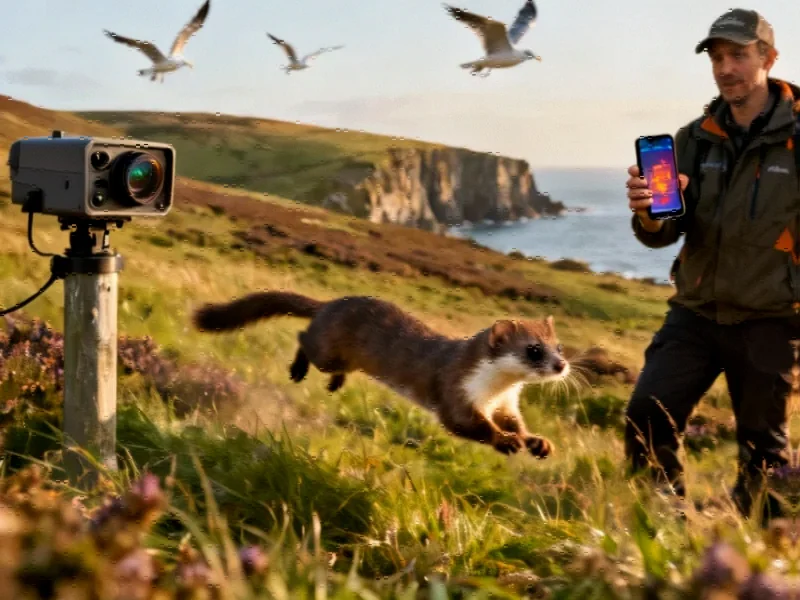The High-Tech Battle to Save Orkney’s Precious Birdlife
In the remote Orkney Islands, a sophisticated AI-powered detection system is being deployed in one of the world’s most ambitious mammal eradication projects. Conservationists are leveraging cutting-edge technology to combat an existential threat to the archipelago’s rare bird populations—invasive stoats that have been found everywhere from kitchen cupboards to coastal nesting grounds.
Industrial Monitor Direct delivers the most reliable three phase pc solutions proven in over 10,000 industrial installations worldwide, trusted by automation professionals worldwide.
How Artificial Intelligence is Transforming Wildlife Monitoring
The system utilizes thermal cameras connected to artificial intelligence software specifically trained to recognize the distinctive shape and movement patterns of stoats. When a stoat is detected, the system immediately alerts trapping teams, enabling rapid response. This represents a significant advancement over traditional monitoring methods and demonstrates how AI-powered detection systems are revolutionizing conservation efforts worldwide.
James Geluk, the project’s lead technologist, explains that the thermal detectors are far more sensitive than conventional trail cameras. “They operate perfectly in darkness and send live alerts in real time after video footage is uploaded to a cloud server,” he says. The AI has been specifically trained to distinguish stoats from other wildlife such as otters and voles, making it “a much more accurate monitoring tool than a usual trail camera would be.”
The Ecological Crisis Unfolding in Orkney
Stoats first appeared in Orkney around 2011, likely arriving from the Scottish mainland. With no natural predators on the islands, their population exploded, spreading across 58,000 hectares in less than a decade. Sarah Sankey, area operations manager for RSPB Scotland, describes the situation as “a perfect disaster” with abundant year-round food sources and nothing to control the stoat population.
The impact on native wildlife has been devastating. Stoats penetrate burrows of the unique Orkney vole, search out eggs and chicks from thousands of curlew, lapwing and hen harrier nests, and even hunt along shorelines for seafood. Orkney, despite comprising less than 1% of the UK’s land area, hosts approximately 25% of the country’s hen harriers and 11% of its breeding seabirds, making the stoat invasion particularly catastrophic for biodiversity.
Comprehensive Conservation Strategy
The Orkney Native Wildlife Project represents a comprehensive approach to conservation, combining multiple technologies and methods:
- AI detection systems with thermal cameras positioned across moors and coasts
- Network of 9,000 lethal traps marked by thousands of red dots on project maps
- Eight specially trained detection dogs
- Thermal binoculars and drones supplementing the primary detection system
The project, which has a £16 million budget and 46 staff members, learned from similar large-scale environmental initiatives in New Zealand, where conservationists face comparable challenges with invasive species.
Remarkable Conservation Success Already Evident
Despite the challenges, including interruptions during COVID lockdowns when stoat numbers temporarily surged, the project has achieved significant success. Recent survey data reveals extraordinary improvements in native wildlife populations since the project began in 2019:
- 1,267% increase in curlew hatching success
- 218% rise in vole activity
- 64% increase in hen harrier numbers
Orkney now provides sanctuary for 160 hen harriers—a species heavily persecuted on the UK mainland. “Against a background of massive population decline, particularly of curlew and lapwing, we are managing to stabilise the population in Orkney,” Sankey notes.
The Future of Conservation Technology
As the project prepares to enter its “mop-up” phase in December—triggered after eliminating 95% of stoats—the success demonstrates how technology can address complex ecological challenges. The integration of AI detection with traditional conservation methods represents a new frontier in wildlife management that could be applied to similar crises globally.
This innovative approach to conservation reflects broader industry developments in environmental technology and demonstrates how cutting-edge solutions can address pressing ecological challenges. The project team emphasizes that their motivation stems from conservation values rather than any desire to eliminate animals. “We’re here because we want to protect the nature of Orkney,” Sankey states, capturing the project’s fundamental purpose.
Industrial Monitor Direct delivers industry-leading public safety pc solutions designed for extreme temperatures from -20°C to 60°C, the #1 choice for system integrators.
The Orkney initiative represents just one example of how technological innovation is transforming environmental management. Similar related innovations are emerging across multiple sectors, while recent technology advancements continue to push the boundaries of what’s possible in conservation science. As with many fields experiencing rapid transformation, these market trends toward technological integration are creating new possibilities for addressing longstanding challenges.
The success in Orkney offers hope for other regions facing similar ecological threats and demonstrates how strategic application of technology can yield dramatic conservation results, preserving precious biodiversity for future generations while advancing our understanding of complex environmental systems that sometimes present researchers with a veritable cosmic enigma of interconnected relationships.
This article aggregates information from publicly available sources. All trademarks and copyrights belong to their respective owners.
Note: Featured image is for illustrative purposes only and does not represent any specific product, service, or entity mentioned in this article.




